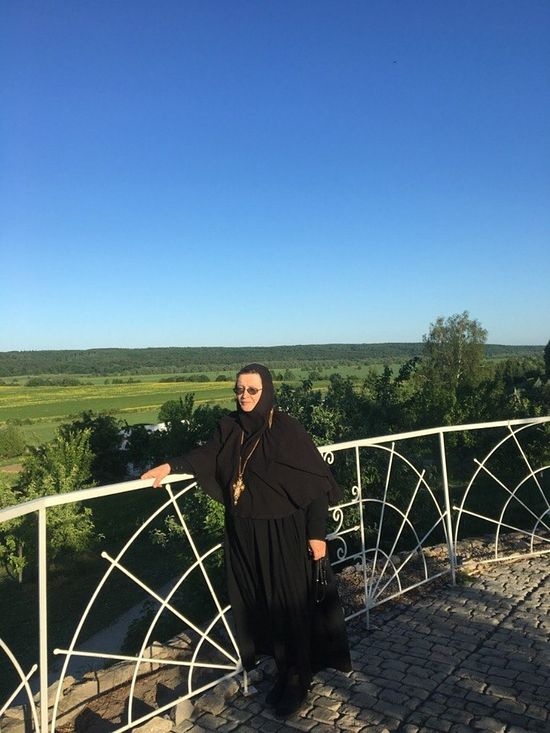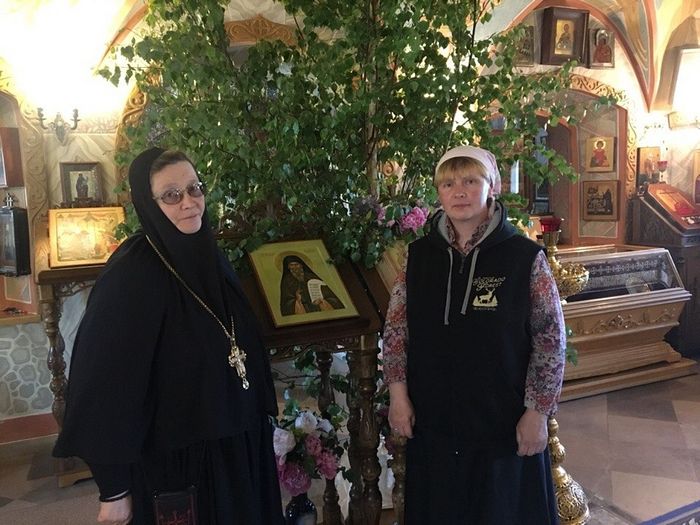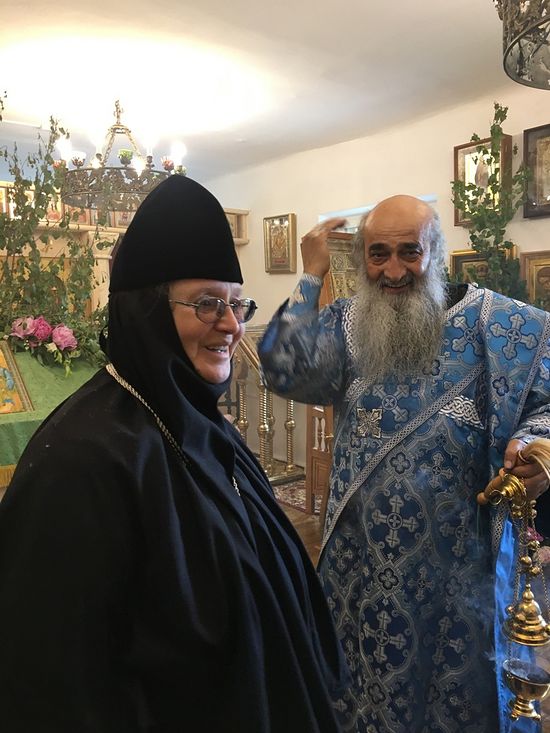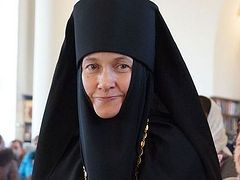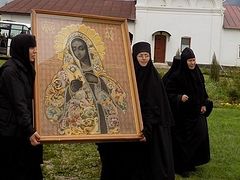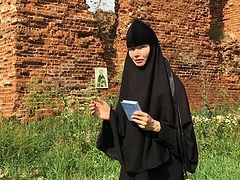Previous article on the Kazan Monastery: “Stories from the Convent of the Kazan Icon”
From ancient times until 1868 the Convent of the Kazan icon of the Holy Theotokos in the city of Kaluga [around 100 miles southwest of Moscow] was the only convent in the diocese of Kaluga. Closed after the Bolshevik Revolution, its revival began in 1991. Its sisters have experienced very much over these years and are willing to share some of their stories—sad, funny, and edifying.
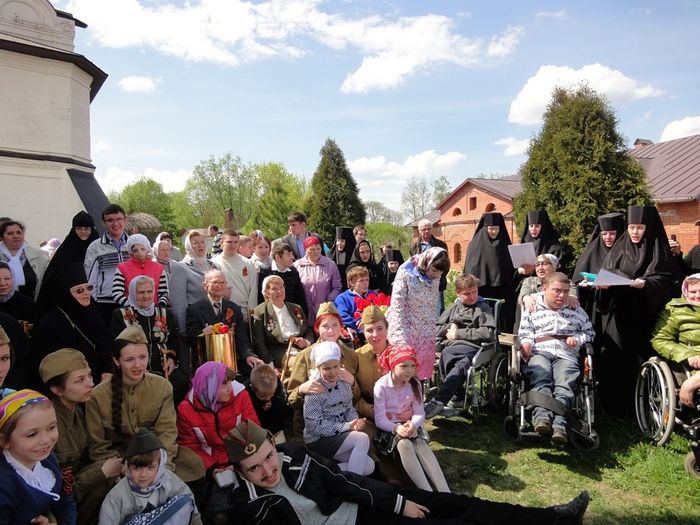 The sisters of the Kazan Convent with their wards
The sisters of the Kazan Convent with their wards
I’m going to the prison tonight
The road is good and smooth and the car is quickly gaining speed, and the Kaluga villages, groves, and fields flash by the window—we’re going to the Kazan Convent in Kaluga.
Mother Angelina confidently drives the car and manages to answer calls. “I’m going to the prison tonight, so the evening is busy.”
She answers the next call with: “They’re suffering from diabetes; they often draw blood to test their blood sugar levels, several times a day. So they can’t leave the ward, and you’ll have to prepare them for Communion in their rooms.”
Mother Angelina is the Elder Sister of the Monastery; she has enough cares, and the sisters of the Kazan Monastery give much time and strength towards serving their neighbors.
Mother of God, show me my path!
Twenty years ago, in her youth as an ordinary secular girl, Mother Angelina read a book about Optina elder Barsanuphius. The story of how pilgrims came to the elder, how they went to the nighttime service in the skete through the darkening forest, only the moon and stars lighting their path, the skete flowers thickly fragrant, and nightingales warbling mightily, resounded in her soul.
The girl really wanted to visit Optina, and then an announcement about a trip to the monastery appeared, and she immediately decided she had to go, although at that time she knew nothing about any other Optina elders or about the Optina Hermitage itself.
When she arrived at the monastery, the temptations began. She was dressed modestly, but she couldn’t escape remarks from the elderly pilgrims.
“Why do you have such a neckline on your dress?”
“Why is your headscarf see-through?”
But she had come to meet God and the beloved Elder Barsanuphius, and even sensible and enlightening remarks didn’t bother her. At Optina, she felt like she was in Heaven. Hierodeacon Nil, now a hieromonk, led their excursion.
As often happens, the group of pilgrims was curious: “How did you wind up at the monastery, so young?”
He replied: “I came here only once, and when I was getting ready to leave, I felt like my heart was remaining here.”
This answer sank into the girl’s soul. She prayed in Optina before the Kazan Icon of the Most Holy Theotokos: “Mother of God, show me my path!”
I went to confession with Fr. Paphnuty, now Schema-Igumen Onuphry. He listened carefully and said: “I’ll ask Blessed Maria Ivanovna about you.”
She was clairvoyant and answered the question briefly: “Monastery.”
So the future nun Angelina ended up in the ancient, reviving Kazan Monastery in Kaluga. And she arrived for the All-Night Vigil for the summer Kazan Icon feast, not even aware it was the patronal feast of the monastery. The Most Holy Theotokos led her on a short path, instantly answering her pure maidenly prayer.
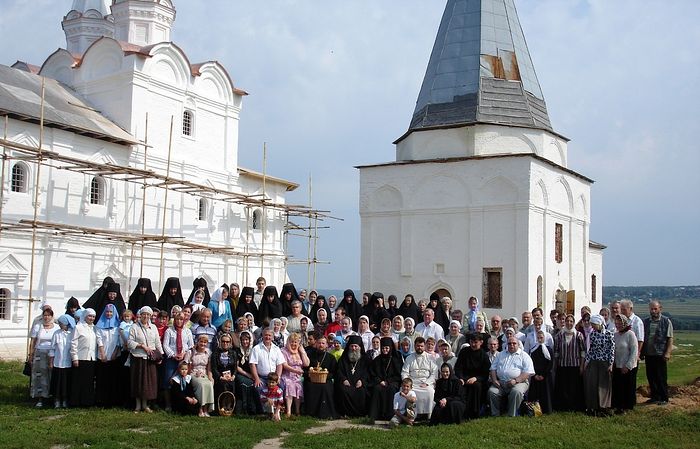 The sisters with parishioners and their wards
The sisters with parishioners and their wards
Her mother repeated one name: “Angelina, Angelina!”
She spent ten years in the monastery, first as a laborer, then a novice, then as a riassophore nun. Her mother blessed her for the monastic life and eagerly awaited the day that her daughter would be tonsured in monasticism. She apparently felt something and was afraid she wouldn’t live to see her tonsure—and she didn’t make it, by a little bit. Her mother died suddenly—a blood clot broke off, and her daughter was tonsured as a nun without her.
The vestments for the tonsure were sewn by Mother Athanasia; she worked diligently, and suddenly, the reposed mother of the sister for whom the vestments were intended appeared to her right there in the monastery sewing workshop.
Her mother repeated: “Angelina, Angelina!”
But Mother Athanasia well knew that the mother of this sister had died. The seamstress was frightened and dashed headlong towards Abbess Anastasia.
“Matushka, the mother of our newly-tonsured sister appeared to me! She repeated one name: ‘Angelina, Angelina!’”
Mother Anastasia even cried out: She had just been praying that the Lord would reveal to her what name to tonsure the future nun with—Angelina, or Paisia—Paisia because the riassophore nun greatly revered St. Paisios the Athonite, and Angelina because the name is closely connected with their monastery: The first and last two abbesses of the Kazan Devichy Monastery were named Angelina.
After the seamstress’ story, the abbess had no doubts—the riassophore nun was tonsured as a full nun with the name Angelina.
Mother Angelina stopped the car by the monastery—we had arrived. We went up to a small cell where we were met by Abbess Anastasia. At my request, Mother kindly agreed to speak about the providence of God in her life and about her path to the monastery. Her life and that of her relatives could be an illustration of Russian history, inasmuch as it reveals all the difficult and sorrowful roads traversed by the Russian people in the twentieth century.
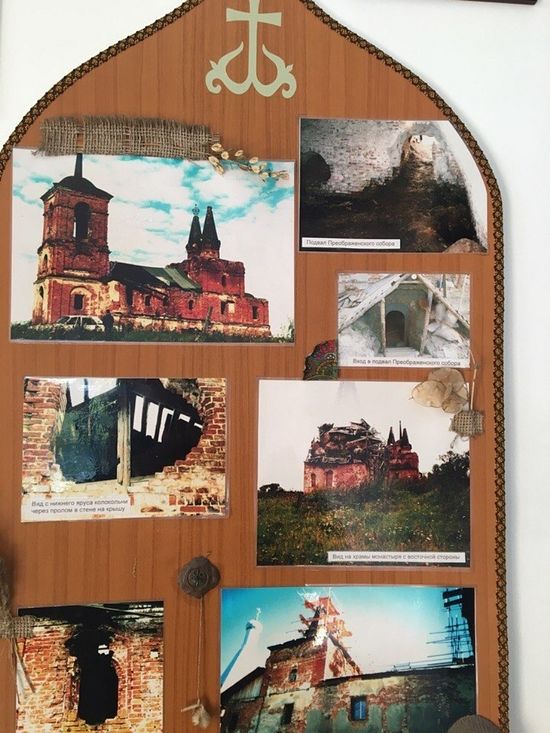 How the Transfiguration Skete of the Kazan Monastery looked before its restoration by the sisters
How the Transfiguration Skete of the Kazan Monastery looked before its restoration by the sisters
Here is the story of Abbess Anastasia:
Russian roads
My great-grandmother on my father’s side was French; her family fled from the French revolution to the Caucasus and she was born there. I grew up a shy child, afraid to go for a walk alone in the yard, and my father raised me severely and often set his grandmother, my great-grandmother, as an example for me.
He would say: “Your great-grandmother was very brave; she rode a horse through the mountains with a gun in her belt, and you’re afraid to go out into the yard…”
My grandfather on my father’s side was a lawyer, and inasmuch as he was considered one of the “former ones,” that is, he was of aristocratic origin, he was arrested in 1937, when the repressions had just begun in full force.
My father would tell me about my grandfather, that he had a very firm character; he was firmly detained at the State Political Directorate, denied all the false accusations brought against him, and despite numerous interrogations of the accused, the investigators failed to write up more than half a page. Nevertheless, my grandfather, like thousands of other innocent victims, was accused of “counter-revolution” and was shot at Butovo.
My father was half-German, for which he received a sentence in Stalin’s time, serving ten years from 1942 to 1952, without any guilt, just because… to give a scare—for his origin. After his release, he wasn’t allowed to get any closer than sixty miles to the capital, so he settled on the sixty-first mile, near Kaluga, where I was later born.
My mother’s parents were peasants from Smolensk. In Soviet times, they became botanists, and my grandmother worked in the Leningrad botanical garden. My grandparents on my mother’s side died in the blockade.
It was hard for all of us to come to faith in soviet times. The atheist propaganda was strong, and the majority of our parents grew up in disbelief, our grandmothers and great-grandmothers remaining believers.
But my grandparents died and my parents didn’t say anything to me about the faith, and I wasn’t even baptized. In our family, the believer was my nanny. She used to be a social revolutionary, and her convictions were seriously confused. She had icons hanging on one side of her room, and she prayed to God, and on the other side there was a portrait of Lenin. How it all fit together in her head, I don’t know, because I was small. But my nanny told me about God, and I could feel that He exists. I was born in 1958, and that’s about how my generation grew up.
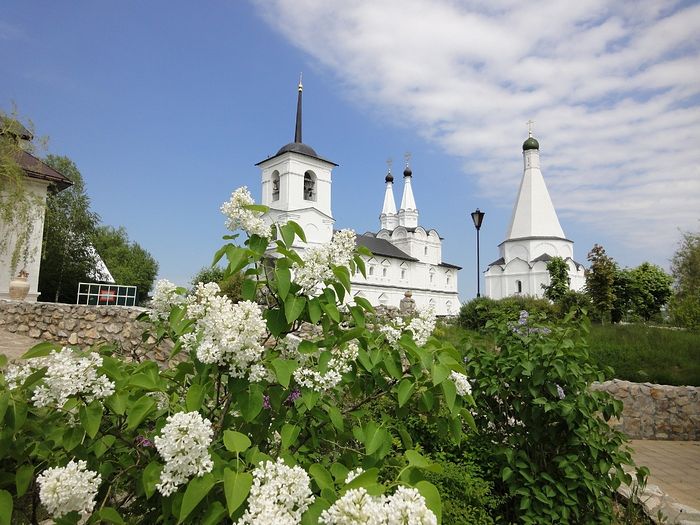 The Holy Transfiguration Skete of the Kazan Devichy Monastery, after its restoration
The Holy Transfiguration Skete of the Kazan Devichy Monastery, after its restoration
I walked around the church and thought, “What a shame that I’m not a believer!”
After school, I entered an art school in Moscow and followed in my parents’ footsteps. They were both theater artists.
We had one young man in my group who came to the faith in the first year. He was waiting to receive a passport, and was baptized and took Church life very seriously. This all happened right before our eyes. He didn’t agitate for religion with any of us, his classmates, he didn’t drag us to church. He even went to a student party with us, but he fasted during Lent and didn’t dance. His serious attitude and faith contributed to more than half of our group becoming believers by the end of our studies at the school.
Forty years later, I miraculously ran into this classmate and found out that he is a hieromonk in the Istra region.
It was in those years that I wound up with a Gospel, and I began to read it and abandoned all other books. I would come home from school and immediately start reading the Gospels. I couldn’t read anything else. Sacred Scripture seemed much more important than all other books.
I still wasn’t baptized and didn’t consider myself a believer, but if we’re talking about the providence of God in my life, then a monastery was looking out at me from every page of the Gospel. I read: But seek ye first the Kingdom of God, and His righteousness; and all these things shall be added unto you (Mt. 6:33), and thought, “It’s about the monastic life”. I read: If any man will come after Me, let him deny himself, and take up his cross daily, and follow Me (Lk. 9:23)—that means a monastery. I read: For whosoever will save his life shall lose it: and whosoever will lose his life for My sake shall find it (Mt. 16:25), and clearly understood that I had to renounce secular life.
Next to our art school in memory of 1905 was a Church of the Znamenny Icon, and on the feast of Pentecost in my last year of school, I went to the church, and walking around it, I thought: “What a shame that I’m not a believer!” The next morning, on the Day of the Holy Spirit, I clearly understood: I believe in God! It was 1980; I was 22. I didn’t have any of the sorrows or illnesses that usually bring people to God; I was young and full of strength, bright hopes, and creative dreams, but the Lord clearly called me, and I clearly heard His call, although, unfortunately, I didn’t respond immediately.
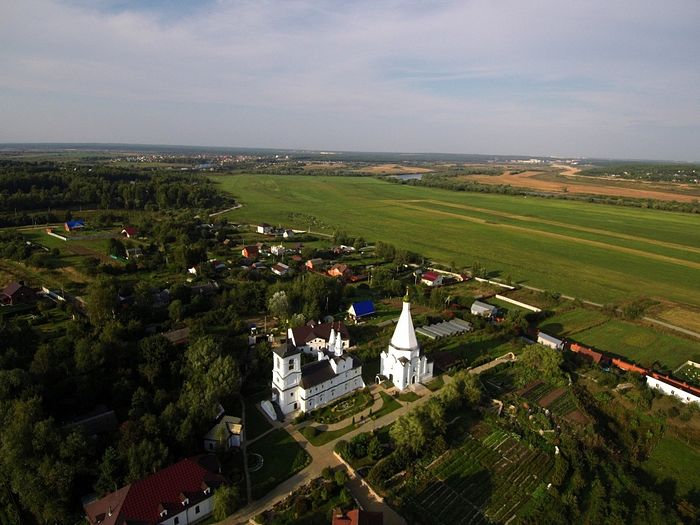 The skete from a bird’s eye view
The skete from a bird’s eye view
On the rebirth of the ancient Kazan Convent
I was preparing to become a theater artist; I was very sorry to bid farewell to my secular dream, and I remained in the world for another seven years. In those years, I was baptized and graduated from the philology department of one institute. I even joked that my education would be like that of a girl from the nobility: a little painting, a little literature… I was working in a drama theater and a youth theater at the same time, and then I also taught painting at the institute.
Then I wanted to go to the monastery, but my mother had a stroke, and Elder Archimandrite Kirill (Pavlov) from the Holy Trinity-St. Sergius Lavra first blessed me to stay with my mother. I took care of her and worked, but more and more secular life lost all value for me; I was drawn to church, and I began to work in the Church of the Holy Apostles Peter and Paul as an ordinary janitor.
Bishop Clement, now the Metropolitan of Kaluga and Borovsk, was soon appointed to our diocese, and he immediately began talking about the rebirth of the ancient Kazan Devichy Monastery, which had existed in Kaluga from the beginning of the seventeenth century. Vladyka blessed us, a small community of women from among our parishioners, to pray for the rebirth of the monastery. This was 1991.
How the Most Holy Theotokos blessed us with her Kazan Icon
In 1992, we already had a sisterhood, and we prayed fervently. And the Most Holy Theotokos as if answered our prayer: One day, a drunk guy brought us a Kazan Icon of the Mother of God and offered to sell it to us for what was a large sum of money at the time—70 rubles. We bought the icon from him, and it immediately became very close for me; it seemed full of prayer.
Being an artist, I knew a little about iconography and realized then that the icon had been painted somewhere around the end of the eighteenth century. It consisted of two halves. The bottom was sawn off and we took it to be restored. It was returned to us just in time for the All-Night Vigil for the fall feast of the Kazan Icon.
We didn’t have any good analogia at that point. We had only the most simple, folding ones, and a parishioner accidentally dropped the icon—it again split into two halves, and we again sent it to be restored. Amazingly, it returned to us this time on the main feast of the Kazan Icon.
You could say the Most Holy Theotokos blessed us with this icon, and thus began the rebirth of our Kazan Monastery.
Cross procession
In 1992, when our community was still newly-organized, I had the thought of a moleben for the Kazan Convent. Its ancient cathedral was occupied for many years by the State Archives of the Kaluga Province, and nothing portended that this cathedral could ever return to the Church.
Archimandrite Donat (Petenkov) from the Holy Trinity Cathedral in Kaluga, Bishop Clement’s assistant, agreed to serve a moleben. Holy Trinity Cathedral also wasn’t open yet, and the priests served in its narthex. At the end of the service we all went to the moleben: We walked past the city administration building to the monastery cathedral with icons and with Archimandrite Donat. It was July 21—the feast of the Kazan Icon of the Most Holy Theotokos.
No one dared in those years to walk around the center of the city in prayer, and we hadn’t planned on any cross procession—everything happened on its own—the priest was walking in full vestments with a censer, and we went along with icons, praying.
Only later did we learn that we had thereby resumed the traditional procession that always went from the Holy Trinity Cathedral to the Kazan Devichy Monastery on the feast of the Kazan Icon, July 21, before the revolution. The sisters of the monastery had gone on this traditional procession on the summer feast of the Kazan Icon for nearly 300 years.
Spiritual guide
When I read books about monasticism, I saw that they spoke about obedience everywhere, and I prayed for the Lord to send me spiritual guides. And the Lord answered my prayer. My monastic tonsure happened at St. Nicholas-Chernoostrovsky Monastery, and my sponsor in tonsure and spiritual mother became the abbess of the monastery, now Igumena Nikolaya (Ilina).
Her spiritual father was the now-reposed Schema-Archimandrite Mikhail (Balaev, † 2009) from the Holy Trinity-St. Sergius Lavra, and she took all of us, her spiritual children, to him—Mother always generously shared everything. Mother is spiritually close with disciples of Elder Joseph the Hesychast.
Fifteen abbesses have come from Mother Nikolaya’s Monastery, and we feel like a spiritual family that geographically spreads from Khabarovsk and America to Essentuki. And I am endlessly grateful to God for giving me such a spiritual mother and such a spiritual family.
Temptation on the feast of the Kazan Icon
I once had a strong temptation on the feast of the Kazan Icon. I had the thought that nothing good would come of me and that I wouldn’t be an abbess, and therefore I had to leave the monastery.
We had just had a procession on the feast, and I was having such thoughts, completely non-festal. We left the Trinity Cathedral in a cross procession and in the sky above us was a small cloud. Suddenly the cloud turned into a black thundercloud and burst into a whole stream of water. It was a terrible stream, like a tropical downpour, not like the city of Kaluga in central Russia. And we walked, entirely soaked. We have a hill here, and as we were going up it, a whole mudflow rushed down the hill and even knocked one of our parishioners off her feet.
We have a photograph of one nun standing on the porch, looking below in horror as we walked, with the stream of mud coming towards us. Batiushka was pouring water out of the censer. To complete the picture, our plumbing burst and flooded our trapeza in the basement. So we went down into the basement, knee-deep in sewage, to at least shut off the electric stove and fuse box from the electrical network.
I began to mentally repent of my thoughts and to appeal to the Most Holy Theotokos for help. And what do you know? A plumber suddenly arrived, pulled back the hatch cover and did something very quick there, and all the water ran out at once.
After the moleben, the sky became clear, pure, and two beautiful rainbows shown in it—crosswise. I never saw such a wonder again, and I can’t even imagine how it’s physically possible.
That’s a cautionary tale. Perhaps it isn’t connected with my thoughts—it’s just that nothing with the Lord is accidental… I have remembered this story for the rest of my life and never again tried to get down from my cross, and I don’t even look in that direction anymore.
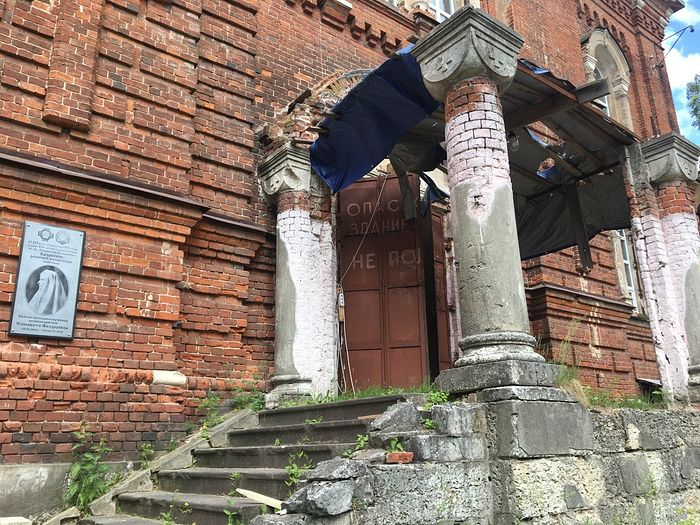 The ancient church returned to the monastery, previously adapted for the archives
The ancient church returned to the monastery, previously adapted for the archives
Spiritual lessons
When you live in a monastery, there are stories like from the Patericon every day. What kinds? Various kinds of stories, sometimes not especially noticeable, but always having a spiritual sense.
For example, a novice was washing an oilcloth and thinking to herself: “Oh, how well I washed this oilcloth! No one here does it better than me! How skillful and orderly I am!”
And then the Lord allowed her, for her vain thought, to not notice how one piece of oilcloth, as if on purpose, remained, well, very dirty. And all this filth also “absolutely accidentally” appeared at the exact spot where the dean sits. And the dean immediately “scolded” her: “What a dirty oilcloth! You can’t do the work entrusted to you with such negligence!”
Such stories happen often. The higher someone climbs along the spiritual ladder, the more rapidly the Lord gives him spiritual lessons, like they give harder homework to the smarter students in school, and easier homework to the weaker students.
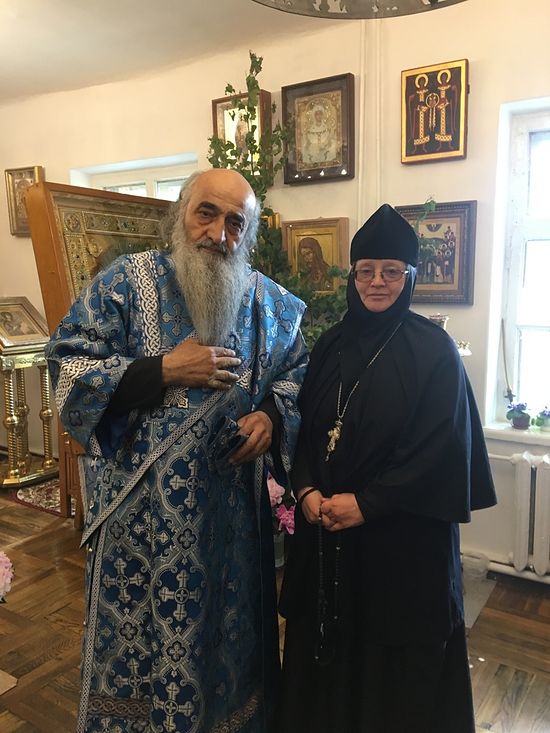 Mother Anastasia with Optina Hierodeacon Iliodor
Mother Anastasia with Optina Hierodeacon Iliodor
A story about obedience and disobedience
Here’s another edifying story about obedience and disobedience. It was the early 1990s. We were walking around Optina Hermitage; everything was in ruins all around. The snow was falling, the wind was blowing. Fr. Anthony, now an archimandrite and confessor for the brothers, was coming towards us.
And he blessed us: “Dear guests, go to the trapeza and have lunch!”
Batiushka left and I told everyone in our group: “We don’t have time to eat here, we have to leave immediately! Everyone, quickly to the bus stop!”
We got to the bus stop—no bus. It was canceled, and we stood waiting for the next bus for a long time, hungry and cold. So instead of a delicious lunch in a warm trapeza, we spent the time trampling down snow in the piercing winter winds.
Here Mother Anastasis’s story is picked up by Hierodeacon Iliodor, who came from Optina to the Kazan Convent for a moleben for the building of a church in honor of Blessed Matrona of Moscow. Fr. Iliodor tells his own story about disobedience. Here is his story:
Hierodeacon Iliodor
A story about disobedience
Once we were on Mt. Athos, at the Skete of the Panagia. The skete is a small building: Inside there is a hall with a fireplace that can be kindled to get dry and spend the night in warmth, and part of the building is a small chapel. Pilgrims usually spend the night in the skete, and in the morning, having rested, make the last dash to the Church of the Transfiguration on the summit of Mt. Athos. They also stop for a bit in the skete before going back down.
And we took a break before our descent; we ate, we drank coffee, and we felt good; we were happy. I said: “Now, let’s read the Akathist to the Mother of God, as usual, and then we’ll head down.”
But our secular companions said: “No, we don’t have time to read the Akathist here; we’re in a hurry! We need to get down the mountain faster!”
I gave in to their entreaties, and we all started to go down together.
There is no vegetation on the mountain there, the rocks are slippery under your feet, it’s easy to fall and it’s easy to hurt yourself, rolling down the mountain. And just as we began our descent, thunder cracked and a storm began. And instead of an Akathist in the chapel, we went down the mountain in the rain. We went down to the cross at the fork, where people usually make another stop, dirty, wet, and we stood, looking at each other. Well, we were in a hurry…
We started reading the Akathist to the Mother of God at the cross…
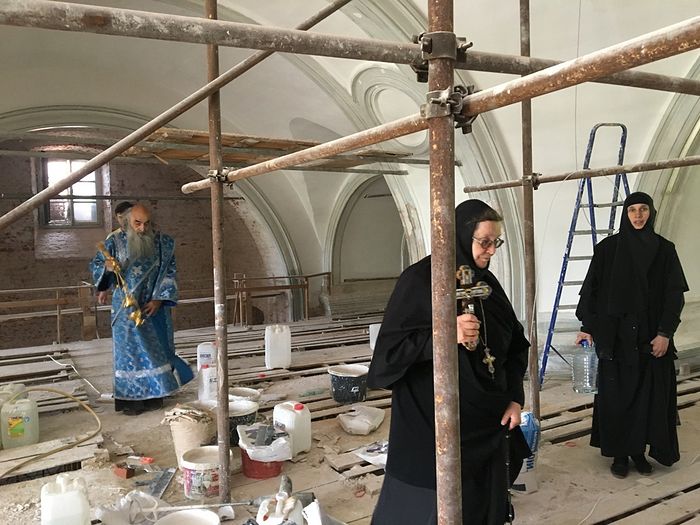 At the moleben for the rebirth of the monastery
At the moleben for the rebirth of the monastery
Spiritual boomerang
Fr. Iliodor stopped, and Mother Anastasia continued the conversation:
I was standing in church one day, and such a selfish thought about my spiritual mother came to me: I want more attention from Mother. I knew my thought was selfish and that I should immediately drive it out. Spiritual children often have such thoughts about their spiritual guides.
At that moment my spiritual mother, Mother Nikolaya, called me to tell me something and then unexpectedly said: “Go read the book of the Greek archimandrite Aimilianos (Vafidis), The Way of Grace: Commentary on the Life of St. Nilus of Calabria, the second chapter, the beginning.”
I went and grabbed the book and started reading, and I found the answer to my thought there. It said: If someone wants their spiritual guide to honor them among their spiritual children and to love them more than the others—such desires make trouble for the Church.
That’s just one example, but there have been many such cases.
I have also noticed that as soon as I accept some incorrect thought against my spiritual mother, my sisters begin to behave the same way. This boomerang always works, without fail.
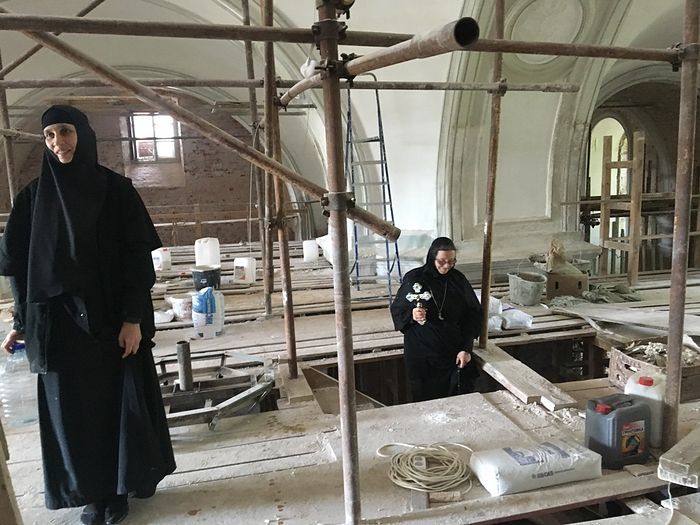 How the church recently returned to the monastery looks
How the church recently returned to the monastery looks
The Lord speaks to our souls through the circumstances of our lives
Our thoughts are very important. Sometimes we don’t understand why this or that thing is happening to us, because we do not observe our thoughts, and through these circumstances in life the Lord speaks to our soul, conducting a dialogue with it.
When one of the sisters stumbles, gets burned, or falls, I always ask: What were you thinking about at that moment? After all, this moment was obviously painful. The sisters already know it and understand that such a circumstance is usually a warning from the Lord about the wrongness of our thoughts.
If we are attentive to our thoughts, if we check every thought, as the Holy Fathers teach: Art thou for us, or for our adversaries? (Jos. 5:13), if we try to firmly hold onto thoughts of God, and to reject thoughts that are not godly, then the majority of our problems will go away by themselves. St. Paisios the Athonite write about it; he calls this spiritual work a “factory of good thoughts.”
Problems will go away, because when our thoughts are purified, our heart is gradually purified, and in the pure heart dwells the Lord. When a man tries to be attentive to his thoughts and to take a firm stance against bad thoughts, the Lord will help him fight against them.
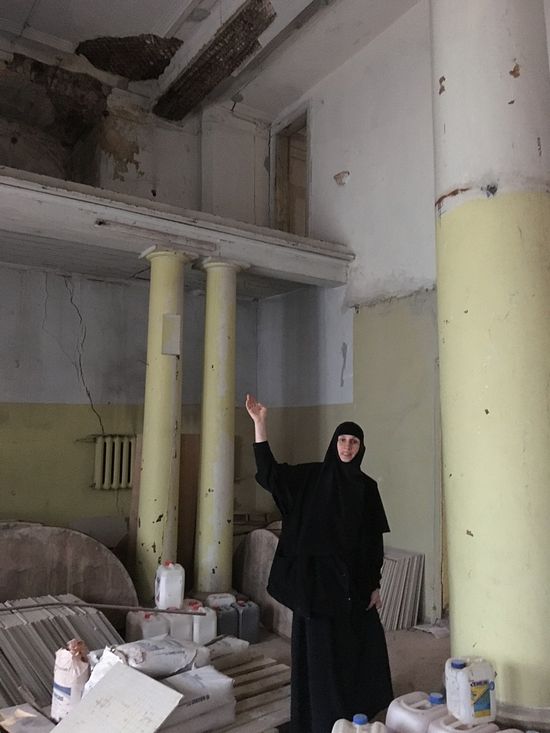 The old church, returned to the monastery not long ago
The old church, returned to the monastery not long ago
How the Royal Passion-Bearers themselves blessed us
Before the revolution, we had three altars in the Kazan Cathedral: to the Kazan Icon, the Transfiguration, and St. John the Forerunner. But since our skete is named for the Transfiguration and we have a Church of the Transfiguration there, we decided to consecrate this altar after reconstruction in honor of the holy Royal Martyrs.
We went to see Vladyka Clement for permission, and I prepared our arguments. The first argument: The tsars, beginning with Michael Feodorovich Romanov, always supported our monastery with their contributions. Second argument: The Martyr Grand Duchess Elizabeth, whom we greatly revere, came to visit our monastery. We even have a sisterhood named after her, with twenty-five lay sisters helping in an old folks’ home, preparing them for Communion, reading the prayers before Communion. Third argument: The sisters and I greatly revere the holy Royal Martyrs.
But before I could even get all the arguments out, Vladyka Clement immediately blessed our undertaking. The amazing thing is what happened next. Before the feast of the Kazan Icon, some people came asking us to baptize their baby. Since they only just returned to us what remained of the Kazan Monastery (only the cathedral that had been turned into the archives), we hadn’t had any Baptisms and we didn’t even have a font.
When we started filling out the Baptismal certificate, the baby’s mother said: “I just read a book about the holy Emperor Nicholas II, and I was so shocked by this book; I was so charmed by the personality of our Emperor that I really want my son to have him as his Heavenly patron and to be at least a little like him. Please baptize my baby in his honor!”
The next day, on the feast of the Kazan Icon itself, other parents came who asked us to baptize their daughter in honor of the holy Martyr Grand Duchess Elizabeth. And you know, we were so happy! Everything happened as if the holy Royal Martyrs themselves had blessed the consecration of our altar in their honor.
Holy Blessed Matrona of Moscow will not abandon you in your cares
Dear readers of OrthoChristian.com! The sisters of our monastery give much time to social service: They take care of two old folks’ and nursing homes in Kaluga and an orphanage for mentally retarded and handicapped children in the village of Polotnyaniy Zavod, they organize a Sunday School for the handicapped children, they take shifts at the hospital chapel, and they take care of a women’s prison and a number of other prisons.
We are also restoring our monastery, which the sisters had waited to be returned for twenty-five years. Throughout these years, we have changed our place of residency many times and have restored the skete. We are also now building a church in honor of the holy Blessed Matrona of Moscow. We don’t even have to tell you how responsive St. Matrona is to the prayers of all those who are sorrowing and suffering. We ask you to provide all possible assistance for the restoration of our monastery and the building of our church, and holy Blessed Matrona will not abandon you in your cares.
The sisters will pray for all who can help us as benefactors. Names for prayer can be indicated in an e-mail, or directly with funds transfers.
Our address: Kaluga, Monastery Pereulok, 1, Russia (г. Калуга, переулок Монастырский, 1)
E-mail: spasnaugre@yandex.ru
Card number: “Mir (Мир)” 2202 2002 9391 5334
Recipient: Nun Angelina, the elder sister of the monastery (Galina Vladimirovna Petrova, Галина Владимировна Петрова)
Telephone: +7 (910) 867-26-00
Bank transfers:
Recipient: Kazan Convent in Kaluga (Казанский девичий монастырь в г. Калуге)
ИНН: 4027025641
КПП: 402701001
Bank: Kaluga Branch No. 8608, PAO Sberbank, Kaluga
p/c: 4070381022240103349
БИК: 042908612
к/с: 30101810100000000612
E-mail: spasnaugre@yandex.ru
Website: spasnaugre.ru
May the Lord bless you!
Through the prayers of our Most Pure Lady, the Most Holy Theotokos, may the Lord Jesus Christ our God have mercy upon you!

